Last Updated on January 7, 2024 by Kittredge Cherry
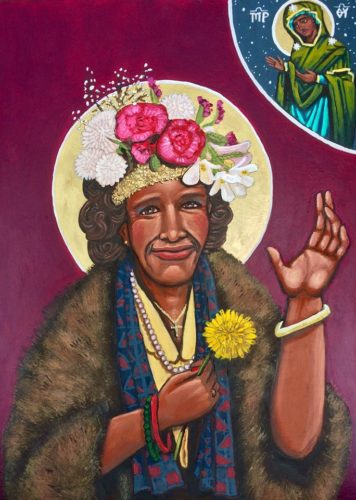
Marsha P. Johnson was an African American transgender woman activist and one of those credited with starting the Stonewall Rebellion that launched the modern LGBTQ liberation movement. A lifelong Christian, she was nicknamed “the Saint of Christopher Street” during her lifetime for her care and advocacy for unhoused queer youth and AIDS patients.
When asked what her middle initial “P” stood for, Johnson famously answered, “Pay it no mind” — the same jaunty reply that she used when people asked intrusive questions about her gender or sexuality. Poverty, discrimination, mental illness and being HIV-positive could not stop her. She was a founding member of the Gay Liberation Front, which sprang up quickly in 1969 as a result of the Stonewall Rebellion. In 1970 she co-founded the Street Transvestite Action Revolutionaries (STAR), an activist and social service organization for homeless gay and trans street kids.
Johnson has surged in popularity in recent years with the rise of the transgender-rights and Black Lives Matter movements. The LGBTQ community seems hungry for more role models who are street activists. Johnson’s defiant, outrageous style resonates with the current polarized era. She embodies resistance. As a black rebel outsider, she’s a welcome antidote to the trope of the passive white saint.
Marsha P. Johnson is a Stonewall star
The LGBTQ people who resisted police at the Stonewall Rebellion (also known as the Stonewall Riots) are not saints in the traditional sense. But they are honored here as “saints of Stonewall” because they dared to battle an unjust system. Some were active in church, but they do not necessarily represent religious faith — they stand for the human spirit and faith in ourselves as LGBTQ people. They performed the miracle of transforming shame into pride.
Witnesses disagree about which individual triggered the uprising, when queer people fought back against harassment at New York City’s Stonewall Inn on June 28, 1969. The historical truth is complex. The most commonly named possibilities are all queer people of color: two self-professed “drag queens” Marsha P. Johnson and Latina Sylvia Rivera, and butch lesbian Stormé DeLarverie. All three have denied throwing the first punch or brick at the rebellion.
David Carter, author of the definitive book “Stonewall,” concludes that none of these three actually started the uprising in his well-researched 2019 article “Exploding the Myths of Stonewall” in the Gay City News.
And yet each of them has been called the Rosa Parks of the LGBTQ community. They have come to symbolize the moment when the LGBTQ community stopped accepting abuse and claimed the right to exist.
Faith helped Johnson grow from bullied youth to drag queen
Marsha P. Johnson (Aug. 24, 1945 – July 6, 1992) was born into a working-class African American family in New Jersey. Assigned male at birth, she began dressing as a girl at age 5. While growing up, Johnson was bullied by neighbors and harassed by family for gender-inappropriate clothing and behavior. She switched back to male clothing after being sexually assaulted by an older, 13-year-old neighbor boy. “I was no one, nobody, from Nowheresville until I became a drag queen. That’s what made me in New York, that’s what made me in New Jersey, that’s what made me in the world,” she said.
Raised in the African Methodist Episcopal Church, she was drawn to Catholicism and other faiths while remaining a Christian for the rest of her life. Her faith was deep and personal. “I got married to Jesus Christ when I was sixteen years old, still in high school,” Johnson said in the documentary “Pay It No Mind.” As soon as she graduated from high school in 1963, she moved to New York City with only $15 and a bag of clothes.
In her last interview, she looked back on the importance of Christian faith in her decision to leave home: “I got the Lord on my side, and I took him to my heart with me and I came to the city, for better or worse. And he said, ‘You know, you might wind up with nothing.’ ‘Cause you know, me and Jesus is always talking. And I said, Honey, I don’t care if I never have nothing ever till the day I die. All I want is my freedom.”
On Halloween night 1963, Johnson met and quickly befriended young Sylvia Rivera, an 11-year-old Latinx child who had been forced out on the streets by a family that disapproved of her gender nonconformity. Johnson taught Rivera how to apply make-up, live on the streets, and embrace her trans identity. They were close friends who were both actively Christian while advocating for queer people. They sometimes appear together in images by various contemporary artists.
Prints of Marsha P. Johnson and Sylvia Rivera were available from the SleepyDolores Etsy shop
Johnson worked as a drag performer, concocting fabulous outfits by adorning herself with leftover flowers, costume jewelry, garlands of tinsel, bright wigs, shiny dresses and extravagant hats found at thrift stores. She made a big impression as she strutted onstage in red plastic high heels. At first she used the drag name Black Marsha, but soon settled on calling herself Marsha P. Johnson. Famous pop artist Andy Warhol personally photographed her for his “Ladies and Gentlemen” series of silkscreen prints. She had a personal altar at home when possible and attended Catholic, Greek Orthodox, Baptist and Jewish services, quipping that she was “covering all angles.” Rivera recalled a visit from Johnson dressed as the Virgin Mary, preaching religion while carrying a Bible and wooden cross.
Engaging in survival sex, she claimed to be arrested more than 100 times for prostitution. Crossdressing was also a crime at that time, and Johnson was sometimes arrested just because she wore make-up in public. Even the organizers of the gay pride parade banned Johnson and Rivera from participating in 1973, claiming that drag queens were “giving them a bad name.” The pair responded by defiantly marching ahead of the parade.
The police raided the Stonewall Inn when Johnson was reportedly celebrating her 25th birthday. Conflicting accounts say that Johnson started the rebellion by throwing a brick or shot glass.
Johnson herself discusses the Stonewall Uprising — and how the bar was already on fire when she arrived — in a podcast with long-time gay activist Randy Wicker on an episode of “Making Gay History.”
Johnson followed in the footsteps of William Dorsey Swann, an African American drag queen who fought back against police who raided a drag ball in 1888 in Washington DC. — making Swann the first American to lead a queer resistance group, first to self-identify as a “queen of drag,” and and first to use the U.S. legal system to defend the queer community. Both Swann and Johnson were queer black divas who pushed the edges of popular culture and public policy.
Marsha P. Johnson leaves a legacy
Johnson died at age 46 and her body was found floating in the Hudson River. Her death was initially ruled a suicide, but later New York City police reclassified her death as a drowning and possible murder. The case remains unsolved.
New York City announced big plans to commission a statue of Johnson and Rivera in 2019, but the project stalled. Two years later a life-size bronze bust of Johnson was erected temporarily in a park one block from the Stonewall Inn, becoming the first statue of a transgender person in New York City. Afterward it was moved to the city’s LGBT Community Center. Artist Jesse Pallotta sculpted “A Love Letter to Marsha” as an idealized portrait with holes for inserting flowers into her bronze tiara.
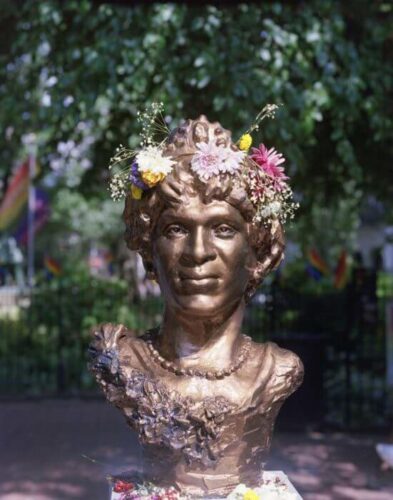
“A Love Letter to Marsha” by Jesse Pallotta (Wikipedia)
Johnson will also be honored with a statue in her hometown of Elizabeth, New Jersey. East River State Park in New York was renamed Marsha P. Johnson State Park in 2020, becoming the first New York state park named after an openly LGBTQ person. A campaign is underway urging the U.S. Postal Service to issue stamps honoring three drag icons: Johnson, Rivera and José Julio Sarria, legendary San Francisco drag queen who founded the Imperial Court in 1965.
Johnson’s life and impact are the subject of several documentaries, including the films “Happy Birthday, Marsha!” (2018) and “The Death and Life of Marsha P. Johnson” (2017). The PBS Newshour profiled her in 2023. There is even a picture book for children ages 4 to 8 titled “Sylvia and Marsha Start a Revolution!: The Story of the Trans Women of Color Who Made LGBTQ+ History.”
The similarities between Johnson, Rivera and medieval saints is explored in depth in the scholarly article “The Afterward: Sylvia Rivera and Marsha P. Johnson in the Medieval Imaginary” by Joy Ellison and Nicholas Hoffman in the October 2019 issue of Medieval Feminist Forum.
Kelly Latimore paints Marsha P. Johnson icon
Marsha P. Johnson has particularly caught the attention of icon painters. The portrait of her at the top of this post was painted in classic icon style by Kelly Latimore of St. Louis, Missouri in 2019. It shows her with a halo behind her gorgeous flowered hat while Mary blesses her from the upper right corner.
Latimore is known for painting innovative icons of unlikely contemporary saints, such as a migrant family in his best-known work “Refugees: La Sagrada Familia.” It appears on the cover of “A Stranger and You Welcomed Me” by Pope Francis. He began painting icons in 2011 while he was a member of the Common Friars, an Episcopal monastic community in Athens, Ohio.
He wrote the following narrative with background info on his Marsha P. Johnson icon for the Q Spirit blog:
“As of late I was very struck by Marsha for many reasons.
I have always been drawn to people living on the margins and as hard as life can be, they are trying to be their whole selves, living their truth, protecting the most vulnerable and doing it with joy and sometimes humor and folly. St. Francis and the various “Holy Fools” comes to mind. Marsha was no fool, but she did struggle with mental illness. (My mother has struggled with severe mental illness going on 20 years.)
But despite that Marsha radiated a joy. Being a queen of joy! Putting flowers in her hair and if she couldn’t make things good it seems she at least tried to make them beautiful! She was a motherly figure to Sylvia Rivera and others on the streets.
All of that juxtaposed with the stories of her faith and stories about lying prostrate in front of the statue of the Virgin Mary after dear friends died of AIDS/ or other hate acts. I can’t remember what street it was on. But she very much connected to God as a woman and I think Mary was a light to her from what I’ve read and understand.
And so having Mary in the icon was very important to me but I wanted it not to be any Mary but a very specific one. And so the Mary depicted is inspired by another icon by Brother Robert Lentz ofm, called “Mother of the Streets.”
And so you have Mary the mother of the streets and then Marsha, mother of the streets.
When I made that connection she had to be in the icon.
So the lettering by Mary is the Greek symbols for Mary.”
Marsha P. Johnson is honored artistically
A stained-glass mosaic from Modern Hexology honors “Saint Martha” with a photographic portrait on a rainbow-inspired backdrop. Her fateful words are embedded in the glass: You never completely have your rights, one person, until you all have your rights.
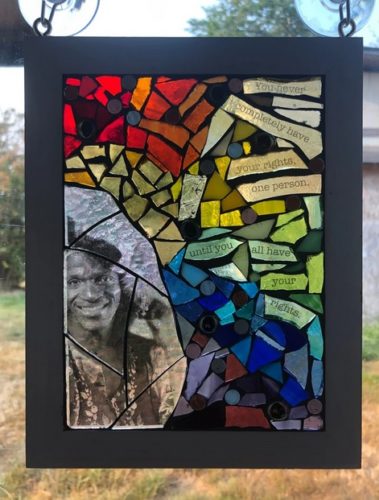
“Saint Marsha” used to be available at the Modern Hexology Etsy shop.
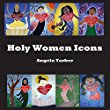 Johnson appears with a large heart and fabulous hat in a colorful contemporary icon by Angela Yarber, founder and creative director of the Tehom Center (formerly Holy Women Icons Project). The background is a patchwork with the LGBTQ rainbow flag, the transgender flag, the brick wall of the Stonewall Inn, and the “Power to the People” sign that Johnson carried in a 1970 photo. The text in her heart expresses her philosophy:
Johnson appears with a large heart and fabulous hat in a colorful contemporary icon by Angela Yarber, founder and creative director of the Tehom Center (formerly Holy Women Icons Project). The background is a patchwork with the LGBTQ rainbow flag, the transgender flag, the brick wall of the Stonewall Inn, and the “Power to the People” sign that Johnson carried in a 1970 photo. The text in her heart expresses her philosophy:
Proud enough to proclaim,
“Pay it no mind,”
Her heart pulsed welcome
And liberation so that
No one would be erased…
Yarber is a painter, minister, author, scholar, dancer and LGBTQ-rights activist based in Hawaii and North Carolina. Nearly 50 color images of her folk feminist icons included in her book “Holy Women Icons.”
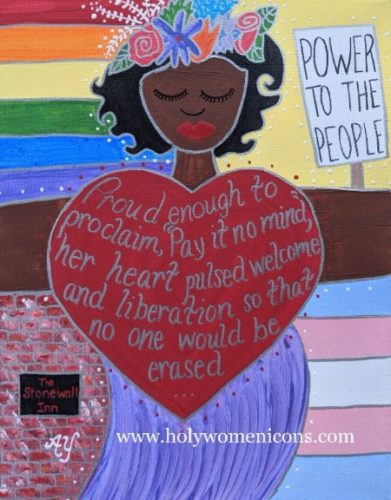
“Marsha P. Johnson” icon by Angela Yarber of Tehom Center
Marsha P. Johnson quotes
Another reason for Johnson’s appeal is that she was quite quotable. Here are a few of her most popular quotes:
“How many years has it taken people to realize that we are all brothers and sisters and human beings in the human race? I mean how many years does it take people to see that? We’re all in this rat race together!”
“Darling, I want my gay rights now. I think it’s about time the gay brothers and sisters got their rights… especially the women.”
“History isn’t something you look back at and say it was inevitable. It happens because people make decisions that are sometimes very impulsive and of the moment, but those moments are cumulative realities.”
Marsha P. Johnson prayers
Q Spirit’s Litany of Queer Saints includes this line:
Saint Marsha P. Johnson, Stonewall instigator, revolutionary black trans activist, Andy Warhol model, drag queen, pray for us and come to greet us when our mortal life is over.
Links related to Stonewall and Marsha P. Johnson
The myth of Marsha P Johnson: Fred Sargeant, veteran of the Stonewall riots, on how trans ideologues are rewriting gay-rights history (spiked-online.com, 2023)
Book: “Stonewall: The Definitive Story of the LGBTQ Rights Uprising that Changed America” by Martin Duberman, classic re-released in 2019
Book: “The Stonewall Reader,” edited by New York Public Library, 2019
Book: “Stonewall: The Riots That Sparked the Gay Revolution” by David Carter
Video: “American Experience: Stonewall Uprising”
2015 book for teens: “Stonewall: Breaking Out in the Fight for Gay Rights” by Ann Bausum
___
Top image credit:
Marsha P. Johnson icon by Kelly Latimore.
___
This post is part of the LGBTQ Saints series by Kittredge Cherry. Traditional and alternative saints, people in the Bible, LGBT and queer martyrs, authors, theologians, religious leaders, artists, deities and other figures of special interest to lesbian, gay, bisexual and transgender and queer (LGBTQ) people and our allies are covered.
This article was originally published on Q Spirit in June 2020, was expanded with new material over time, and most recently updated on June 28, 2023.
Copyright © Kittredge Cherry. All rights reserved.
Qspirit.net presents the Jesus in Love Blog on LGBTQ spirituality.








Hi Kittredge,
Perry and I were brothers in New York GLF. I think he made a slight error. Marsha showed up at the Stonewall on the first night after the rebellion had started, and joined in; Sylvia didn’t customarily hang at the Stonewall, and wasn’t there. Stormé was not the first person to fight back; the identity of the butch dyke who was, and who provided an example for others to follow, is unknown. The late David Carter, who authored the book Stonewall, wrote a thoroughly-researched article, published in Gay City News the week of Stonewall 50, that debunks these mythological claims. You can find it online.
The other myth is that the people who fought back were primarily people of color. While people of color were certainly present, the majority of people who were in the Stonewall at the time of the police raid, and who fought back in the streets, were white. This according to Mark Segal, who was there, and other eyewitnesses. (I was in New Haven at the time, and very much in the closet.)
We in GLF understand full well why transpeople and people of color wish to create mythologies about our past. But there are many people still alive who were there, and who are honest about what they saw and what took place. Marsha was, at least in one interview; Sylvia and Stormé were not. Sylvia, in fact, changed her story as the years went on.
Saints? Lovely thought. Certainly Marsha was a very free and defiant if troubled activist who mixed prostitution with consciousness raising and spirit building. She could be an absolute joy to be with. But Saint? I think you’re trying too hard here.
Jason, it’s such an honor to hear from another Gay Liberation Front pioneer who knew Marsha P. Johnson personally! Thank you for your information and insights. I found the article you recommended (“Exploding the Myths of Stonewall”) and added it to my profile of Marsha here as well as to my Stonewall overview.
I certainly share your desire to be honest about what actually happened. This blog covers art as well as history, so I also cover the ways that historical figures are interpreted and even mythologized over time.
I administer an LGBTQ Saints group on Facebook. When people join, they are asked to name their favorite LGBTQ saint, and I was surprised at how many people named Marsha. She has been named as often as Matthew Shepard.
I knew Marsha very well; she was no saint, but a wonderfully sweet-natured person, and she liked me because I gave her money, even when I had so little of it as a young man. Most of the people, men and women, in the Gay Liberation Front adored her, as opposed to Sylvia Rivera who could be difficult and violent at times. Neither Marsha nor Sylvia were actually at the Stonewall Inn the first night of the rebellion; they came in on the 2nd night.
The person who is the real saint in this story is the long-time activist Randy Wicker, who supported both Marsha and Sylvia for decades of their lives, and who worked so hard to have Marsha’s death investigated as a murder. Randy did it, as well as the people at New York’s very hard-working Anti-Violence Project.
Perry, it’s wonderful to get a comment from someone who knew Marsha personally! Thank you very much for sharing some of your memories of her and Sylvia. When I saw your name, I remembered your novel “King of Angels.” Your comment motivated me to add a link to a podcast where Marsha and Randy are interviewed together about Stonewall and much more.
Marsha got there after the bar was on fire. I do believe Marsha was a Saint because She lived with me for over ten years. Your suggestion that I was a saint for helping Marsha and Sylvia over the years is lovely but misguided. Having Marsha as a roommate was the greatest blessing of my life. Marsha brought joy into my life. Sylvia also helped me so much when things were out of control in my Hoboken apartment. Yes, she was difficult but toward the end of her life, she was delightful — after stopping her drinking and totally devoting herself to activism and feeding the homeless at the MCC Church.
Saint Marsha brings together, in the arms of her powerful embrace, the diverse and related themes of Black Lives Matter, Pride Month, being safe in the Coronavirus Pandemic (which impacts the poor and marginalised much more deeply than those who are the empowered custodians of oppressive hegemony), and the ongoing struggle for cultural/political change. Thank you, Kitty, for sharing and helping us to become better informed.
Sylvia could be violent and destructive. In 1973, MCC New York, then meeting in the Methodist church on 7th Avenue and 13th Street, had just set the altar for the 7pm service, when Sylvia came in, grabbed the chalice, hand crafted by pastor Gil Lincoln, and threw it against the altar, spraying grape juice all over the carpet in front of the altar. Student Clergy, Marge Ragona, cleaned it up before worship. Sainthood came later! Sylvia was a pretty destructive teenager who was mad at the world and apparently mad at the church. I don’t think she even knew what MCC was or that it was MCC meeting in that church. GIL has passed on due to AIDS but was District Coordinator of GLAD, when I founded the MCC at Mobile, now Cornerstone MCC, in 1985.
Thanks for cleaning up Sylvia’s mess and giving us the full picture of Sylvia’s violent, destructive side. At Q Spirit, I try to present the full lives of “saints,” showing that they were flawed human beings like the rest of us, and therefore sainthood is within the reach of all.
I wrote a more in-depth article about Sylvia Rivera at this link:
https://qspirit.net/sylvia-rivera-stonewall/
In her later years she became an active member of Metropolitan Community Church of New York, where she directed the food service program that feeds the hungry and ministered at the queer youth center. These were renamed in her honor as the Sylvia Rivera Food Pantry and Sylvia’s Place.